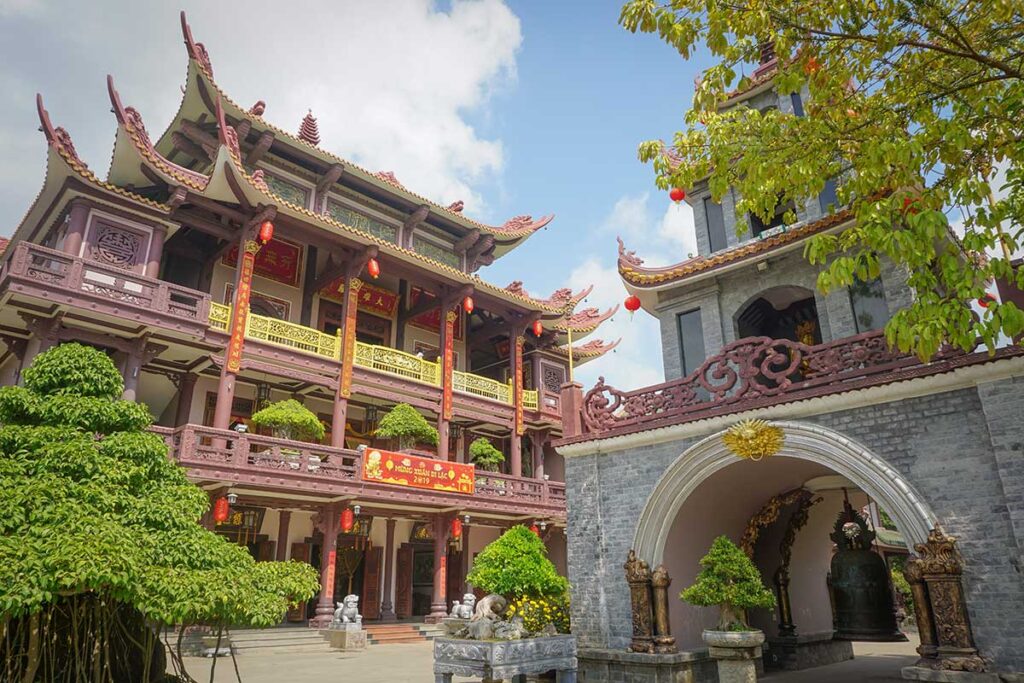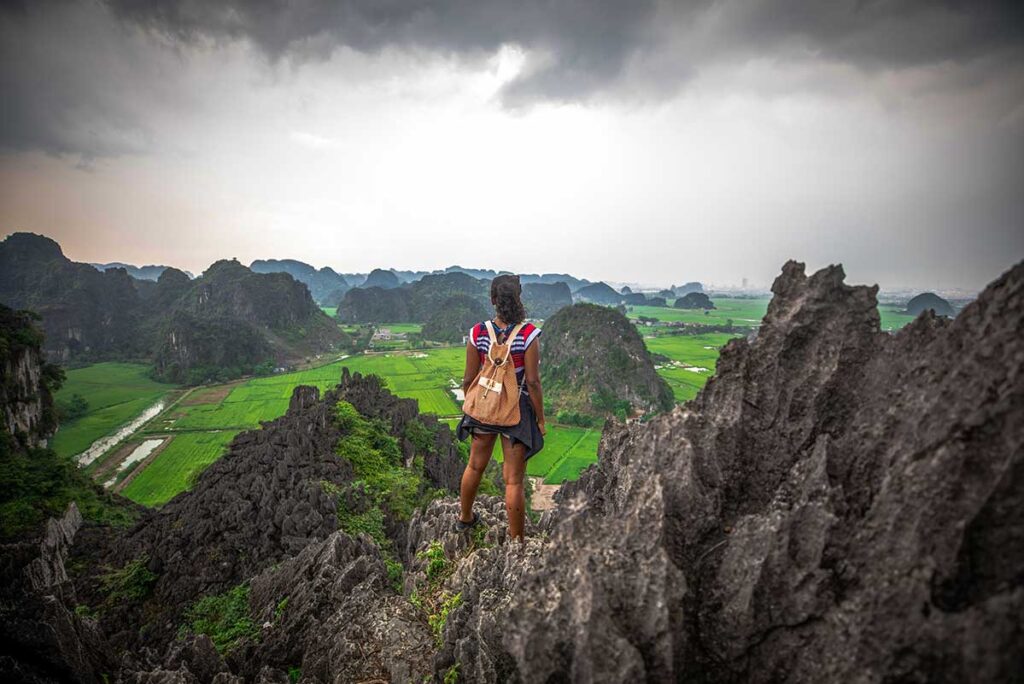What is Thien Hung Pagoda like?
Location & surroundings
Thien Hung Pagoda sits in Nhon Hung Ward, An Nhon Town, about 20 kilometers northwest of Quy Nhon. The drive takes you along National Highway 1A, with stretches of rice fields and small villages framing the approach. The rural setting gives the pagoda a calm backdrop, especially compared to the bustle of Quy Nhon city.
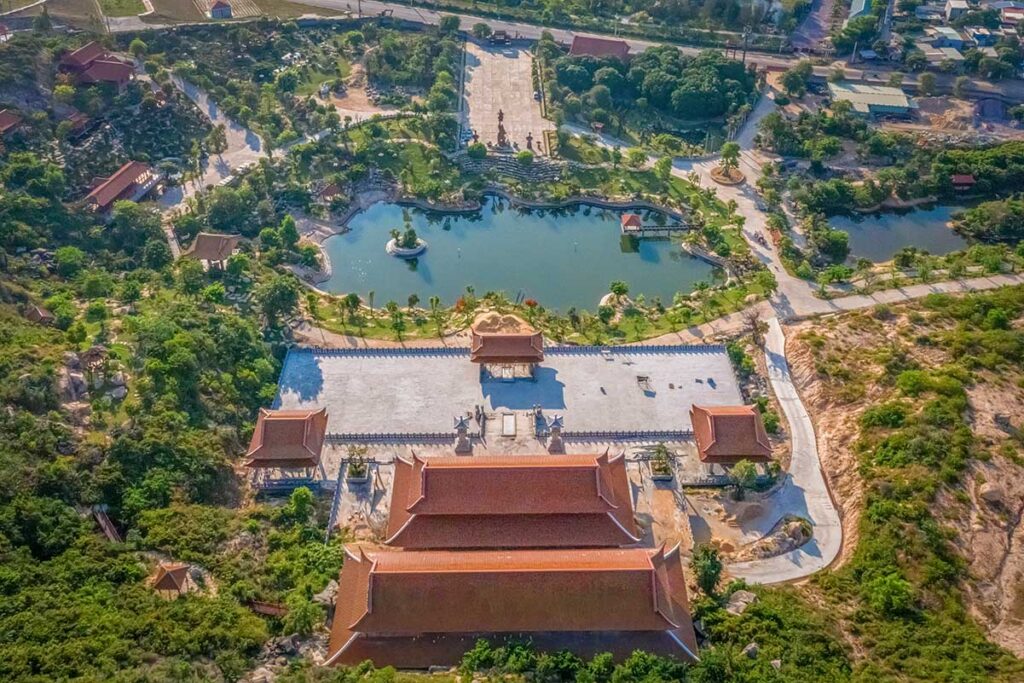
Because of its location, it’s easy to combine a visit here with nearby Cham heritage sites such as Banh It Tower and Canh Tien Tower, or with a short stop in An Nhon’s historic center.
Background & why it’s here
Unlike many of Vietnam’s famous temples, Thien Hung Pagoda is relatively new. It was founded in the 2000s under the guidance of Abbot Thich Dong Ngo, who designed much of the layout and architecture himself. The style mixes traditional Vietnamese Buddhist elements—such as sweeping tiled roofs and carved details—with a modern sense of scale, resulting in a complex that feels both familiar and distinctive.
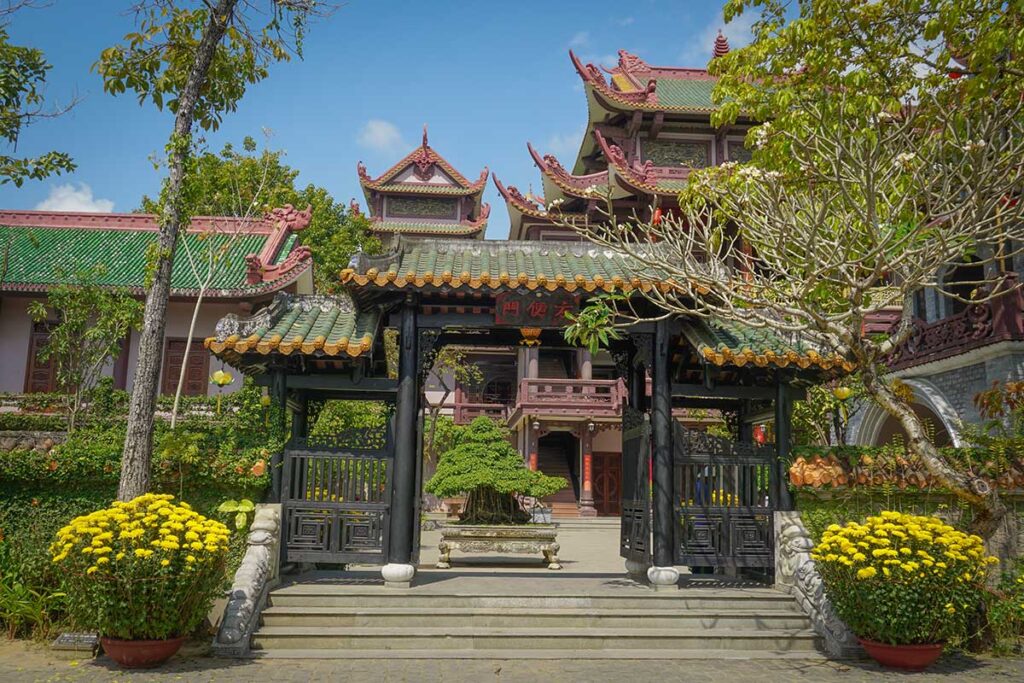
Beyond the architecture, the pagoda is spiritually significant because it houses a sacred Buddha relic (Ngoc Xa Loi) gifted from Myanmar, which makes it a place of pilgrimage for many Buddhist followers in the region.
Daily life & atmosphere
This is not just a monument but a functioning monastery. Monks and novices live, study, and train here, and you may hear chanting or catch a glimpse of their daily routines while walking through the grounds. Some areas may be closed depending on the time of day or religious activities taking place.
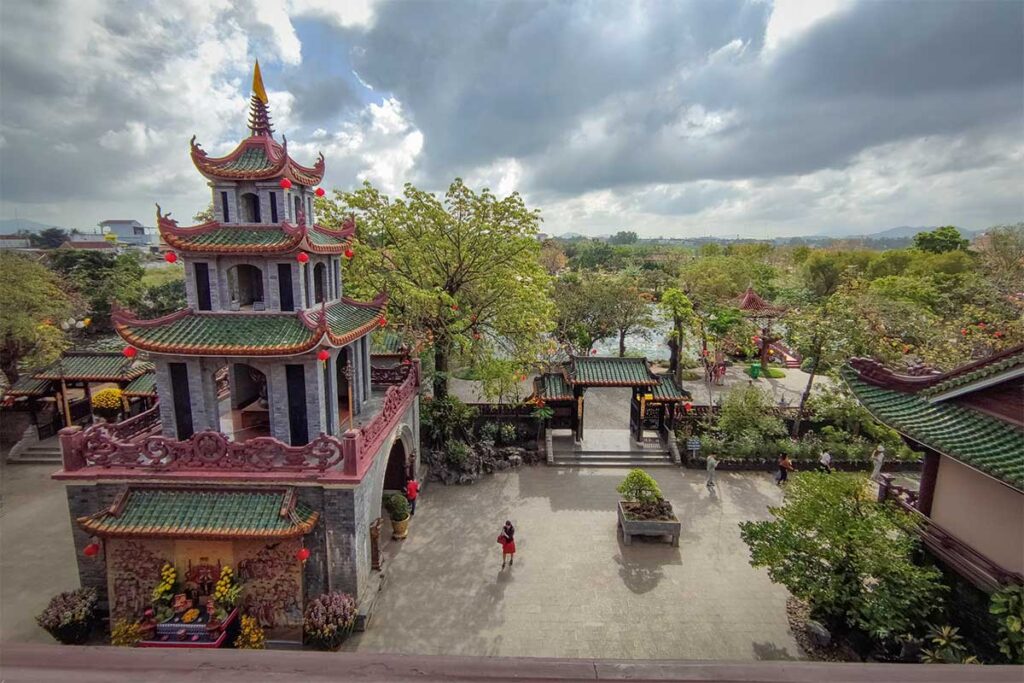
For visitors, the appeal lies in the atmosphere: shady gardens, lotus ponds, and quiet corners where you can pause for reflection. It feels like a living place of faith rather than a museum, which adds to its authenticity, even if it lacks the historical depth of the nearby Cham sites.
Highlights of visiting Thien Hung Pagoda
There’s enough here for an unhurried hour, especially if you take time to wander the gardens, pause by the pond, or climb the stupa when it’s open. The complex isn’t overwhelming, but it offers a mix of spiritual landmarks and quiet corners that make the visit feel more meaningful than a quick photo stop.
1. Thien Ung Stupa (12-story tower, ~40 m)

The twelve-story Thien Ung Stupa is the pagoda’s landmark feature and can be seen from a distance as you approach. At around 40 meters tall, it dominates the skyline and offers panoramic views of An Nhon and the surrounding countryside if the upper levels are accessible. Even if you don’t climb it, the stupa makes for striking photos, especially when reflected in the pond or framed by the gardens.
2. Main hall (multi-level worship space)

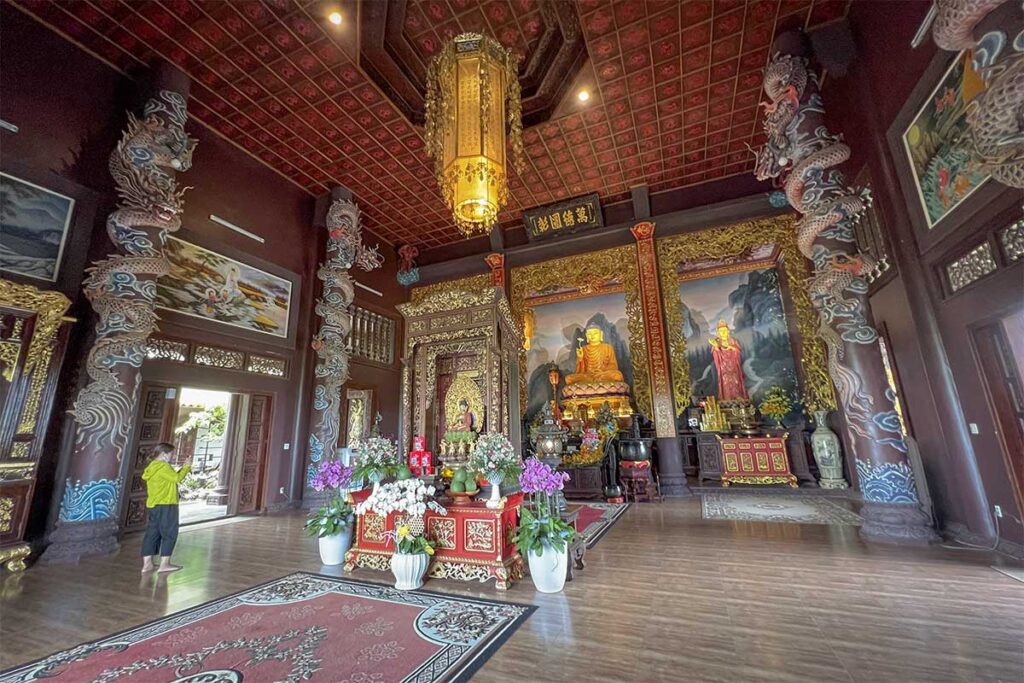
The main hall is a multi-level building where different floors are dedicated to Buddha and Bodhisattva figures, including a thousand-armed Guanyin and a central Shakyamuni. The atmosphere inside is solemn, filled with incense and the quiet hum of daily practice. It’s one of the best places to feel the spiritual weight of the site.
3. Gardens, lotus pond & bridges
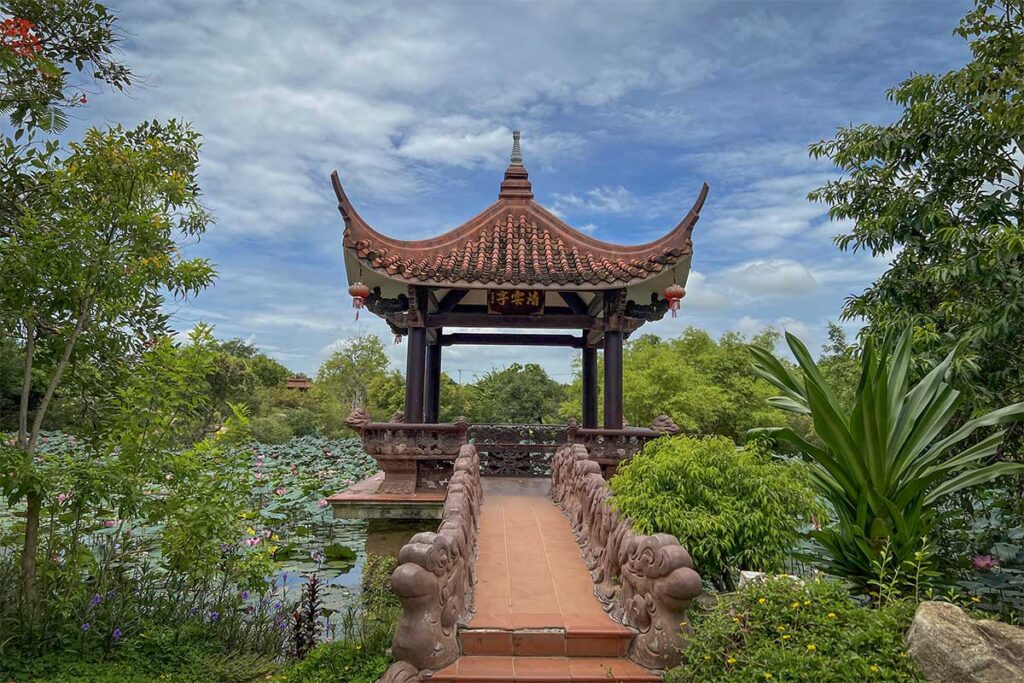
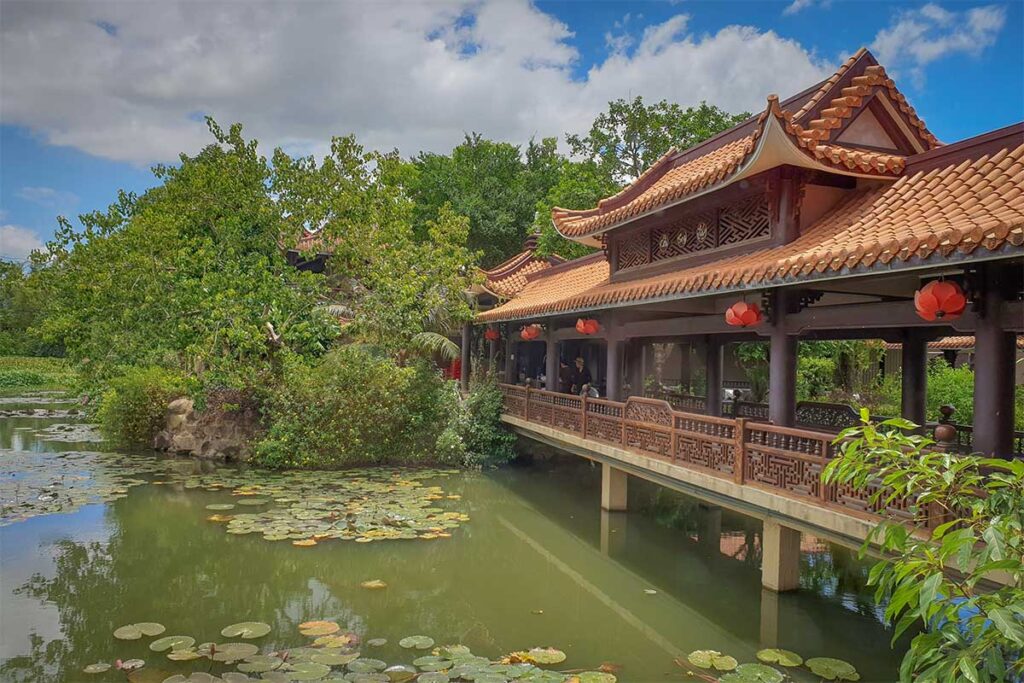
Much of the pagoda’s charm lies outside. A large lotus pond with small ornamental bridges creates a calm, reflective setting. Shady paths wind through carefully tended gardens, making it a pleasant place for a slow walk or to sit for a moment away from the sun. Early mornings and late afternoons are when the light is at its best for both photos and comfort.
4. La Han terrace (Arhat statues)
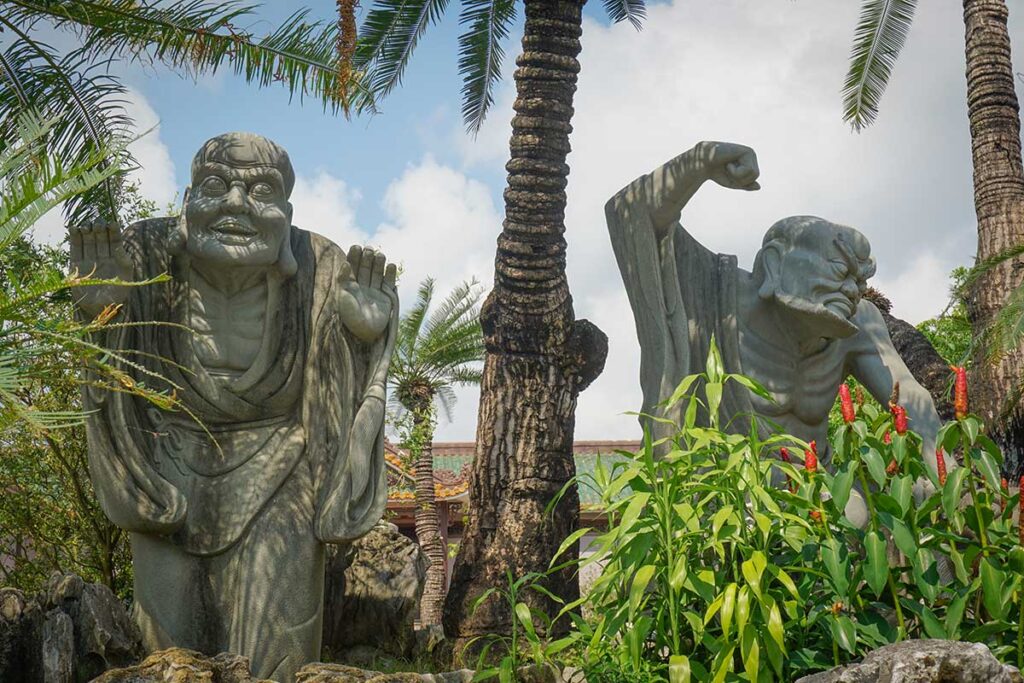
One corner of the grounds features 18 massive sandstone statues of Arhats, enlightened disciples of the Buddha. Each stands about three meters tall and has its own distinct expression and pose, making the row both impressive and surprisingly characterful. It’s one of the most photogenic spots at the pagoda, set among trees and garden paths.
5. Relic connection (Ngoc Xa Loi)
– Thien Hung Pagoda is spiritually significant because it houses a sacred Buddha relic brought from Myanmar. The relic itself is a tiny crystal-like fragment said to be from the Buddha’s remains, but here it is sealed inside a statue or shrine, so you won’t see it directly. For pilgrims, this makes the site an important place of worship; for other visitors, it’s worth knowing why the shrine draws such reverence, even if the relic itself is not on display.
6. Daily life of monks

One of the things that makes Thien Hung stand out is that it’s not just for visitors — it’s home to a large community of monks and novices. Depending on the time of day, you might hear chanting from inside the halls, see young monks studying, or notice them tending to the gardens and temple grounds. These glimpses of daily monastic life give the pagoda a sense of being a living place of worship rather than a static tourist spot.
Practical tip: Some areas may be closed while rituals or study sessions are happening, so don’t expect to access every hall at all times. Always be discreet with your camera when people are present.
Location & Getting there
Where is Thien Hung Pagoda?
Thien Hung Pagoda is located in Nhon Hung Ward, An Nhon Town, about 20 kilometers northwest of Quy Nhon. It sits just off National Highway 1A, making it easy to reach if you’re heading between Quy Nhon and Phu Cat Airport. An Nhon itself is a historic town, once part of the old Cham capital, and the pagoda fits naturally into a loop that also includes Banh It Tower, Canh Tien Tower, or even the Hoang De Citadel.
If you’re coming from further away, Quy Nhon is the natural base. The city is connected by flights into Phu Cat Airport (about 30 minutes from the pagoda), trains at Dieu Tri Station, and long-distance buses running the coastal route.
Taxi or ride-hailing
From Quy Nhon, a taxi ride to the pagoda takes about 30–40 minutes. The trip is straightforward, but because the area around the pagoda is semi-rural, ride-hailing apps may not always be reliable for the return journey. It’s a good idea to ask the driver to wait for you or agree on a return time and price before you get out.
Car with driver
Hiring a private car with a driver is another simple option, especially if you want to see more than just the pagoda. Many visitors combine Thien Hung with Banh It Tower and Canh Tien Tower in a half-day trip from Quy Nhon. With this setup, the driver waits for you at each stop, so you don’t have to worry about transport in between. Prices are usually fixed up front.
Renting a motorbike
For independent travelers, renting a motorbike in Quy Nhon is the most flexible and budget-friendly way to get here. The road is mostly easy to ride, though traffic on Highway 1A can be fast-moving, so keep that in mind if you’re less confident. The ride takes you past rice fields and small towns, making the journey part of the experience. Officially you need a valid license with an International Driving Permit for insurance to cover you, though in practice most rental shops won’t ask. At the very least, wear a helmet and ride cautiously, especially in the midday sun when it can get hot on the open stretches.
Practical visiting information & travel tips
Entrance & hours
There’s no entrance fee to visit Thien Hung Pagoda, though donations are welcome. The complex is generally open during daylight hours, but some halls and sections close around mid-day (roughly 11:00–15:00). If you want to explore the grounds without rushing, mornings are the best time.
Best time to visit
Early morning or late afternoon brings cooler air and softer light, which is also better for photography. Buddhist holidays such as Vesak or Lunar New Year can be lively, with ceremonies and lanterns adding atmosphere, but expect larger crowds at those times.
Dress code & etiquette
As with any Buddhist temple in Vietnam, modest dress is important. Cover your shoulders and knees, and remove shoes before entering prayer halls. Keep your voice low and move quietly. A few local customs are worth knowing: don’t step directly on thresholds, avoid using the central gate, and don’t scatter coins or burn large amounts of incense.
Facilities & services
Basic facilities are available: restrooms, shaded seating areas, and occasionally a small drink stall near the entrance. The temple sometimes serves a free vegetarian lunch between 10:00–12:00, but it’s polite to let them know in advance if you’d like to join. Some areas may be closed without notice when ceremonies are happening or monks are studying.
What to bring
Bring a bottle of water, sun protection, and respectful clothing. Small notes (5,000–10,000 VND) are handy if you choose to give alms. A pack of tissues or hand gel can also be useful.
Time needed
Most people spend about 60–90 minutes here, enough time to see the main hall, stupa, gardens, and statues. If the tower is open or you want to linger in the gardens, you could easily stretch the visit longer.
Be aware (real-world notes)
You may encounter beggars in or near the pagoda grounds. Interactions are usually polite, and whether to give is up to you. The main inconveniences are the mid-day closures and the heat, so if you have flexibility, aim for a morning visit.
What is nearby
If you make the trip out to Thien Hung Pagoda, it’s worth combining it with some of the other sights scattered around An Nhon and the surrounding countryside. The area has some of Binh Dinh’s most interesting Cham remains and historical landmarks, all within easy reach.
- Banh It Towers – About 10 km from the pagoda, this is one of the most impressive Cham complexes in Binh Dinh. Set on a hilltop with sweeping views, it combines four brick towers that date back to the 11th–12th centuries.
- Canh Tien Tower – Located in the town of An Nhon itself, this single Cham tower is smaller and simpler than Banh It but still a quick and worthwhile stop if you’re already in the area.
- Duong Long Towers – A little further out, these are the tallest Cham towers in Vietnam, rising dramatically from the fields. They can be visited if you’re doing a longer Cham heritage loop.
- Hoang De Citadel (Do Ban Citadel) – The ruins of the old Cham and later Tay Son capital, with crumbling walls and a sense of history that ties the area together.
- Thap Thap Pagoda – A historic temple built from the remains of fallen Cham towers, once considered one of the most important Buddhist centers in central Vietnam.
- An Nhon Town – A good place for a short stop to grab a local meal or wander the streets, giving you a sense of everyday life in Binh Dinh outside the bigger city of Quy Nhon.
Visiting Thien Hung works best as part of a half-day or full-day route linking one or more of these sites. The combination of modern Buddhist life and Cham-era heritage makes the area more rewarding than any single stop on its own.
Is Thien Hung Pagoda worth visiting?
Thien Hung Pagoda is a beautiful and peaceful complex, with lotus ponds, shaded gardens, and an impressive twelve-story stupa. What makes it more than just another modern temple is that it’s an active monastery — you’re likely to see monks studying, chanting, or tending to the grounds, which gives it a sense of authenticity. If you enjoy contemporary Buddhist architecture and a calm setting, it’s well worth a stop.
That said, it doesn’t have the centuries of history you’ll find at Binh Dinh’s Cham towers. For most travelers, it makes the most sense as part of a wider day out — combining Thien Hung with Banh It, Canh Tien, or Duong Long Towers, and perhaps the Hoang De Citadel. Seen this way, it’s a rewarding stop that fits naturally into the region’s cultural and scenic loop rather than a standalone destination.
